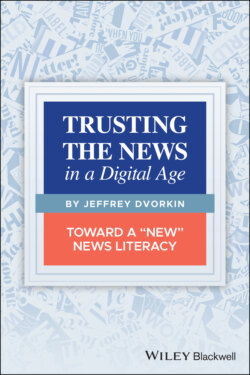Читать книгу Trusting the News in a Digital Age - Jeffrey Dvorkin - Страница 22
2 Changing Definitions of News TAKEAWAYS FROM CHAPTER 2
Оглавление1 Why there is a human need for information
2 How different technologies and platforms change information, sometimes with unintended consequences
3 How the news was changed when the technologies changed
4 How people define themselves by the media they consume
5 Changing cultural, institutional, and economic influences on the news
6 The effect of digital technology on the news
Curiosity is one of our deepest instincts.
And technologies have always been invented and adapted to serve our instinctive need to know.
In Europe until the 15th century, literacy and the technology that served it were limited to the writings (and copying) of biblical texts. This was done exclusively in Latin by church officials whose purpose was to write the Bible out by hand. This was extremely labor intensive, and only one copy of the Bible would be produced over as many as two years.
But in 1455, a German printer named Johannes Gutenberg created a revolutionary invention: movable typesetting. This allowed for more efficient and mechanical printing of the Bible and was an early form of mass production, allowing a copy to be printed once every few weeks rather than every few years. Gutenberg wasn’t the first to come up with this remarkable invention. Korean and Chinese printers invented a similar system two centuries previously. But Gutenberg had no way of knowing this due to the lack of contact between Europe and Asia at that time. His invention was nothing short of revolutionary and changed the way Europeans (and North Americans) communicated.
We need to appreciate the enormous implications of Gutenberg’s moveable type for advancing communication. No longer could authorities, such as the Roman Catholic Church or a local potentate, maintain a monopoly on information. There were frequent attempts over the centuries to control the spread of information, but Gutenberg’s revolution proved to be unstoppable. Print newspapers, pamphlets, and, much later, electronic inventions, such as the telegraph and the telephone, allowed for a more rapid and less controlled spread of information. This coincided with the growth of literacy and public education. As written information proliferated, more people had access to books, and literacy increased. As a result, people became more curious about and engaged in the world around them. A new industrial culture of producing, sharing, and disseminating information accelerated by the early 19th century in Europe and North America. It was the beginning of what we recognize today as the modern news culture.
In the early 20th Century, the news adapted to other new technologies, such as photography, radio, and, by the 1950s, television.
Just as Gutenberg’s invention forever changed the way in which Europeans were able to articulate and express their needs, the application of electricity to new communications methods rapidly changed the world once more. Citizens in countries with access to these new technological advances were enthralled and demanded more information more quickly and more reliably.
Like Gutenberg’s invention, the effect of digitalization on the news was equally transformative. The news as a technological and cultural phenomenon was already highly profitable and hugely competitive. Newspapers in the UK and the US battled for market supremacy with lurid headlines and graphic illustrations and sometimes shocking photographs of actual news events. Throughout this, the culture of journalism and reporting grew to serve this new industry and the insatiable curiosity about other people’s lives.
As digitalization advanced, audiences became connected to the news in a way they had never been. News organizations expanded to serve these new audiences. The power of widespread information as we have seen in the twenty‐first century became a major cultural influence on all aspects of modern life, including political news.
The news makes us wonder what just happened, how it happened, and how whatever happened might affect us personally. Just think of being deprived of information, of being disconnected. How would you feel if you were truly isolated, on a virtual “news desert”? Imagine being off the grid with no smartphone, no texting, no apps, no email, even for 24 hours. The very thought probably makes you nervous: What is happening? How will friends and family get in touch if there is an emergency? Who should you contact to get back in touch? “FOMO” can be a very unnerving idea!
There may be some value in doing a digital detox once in a while to reconnect with our original, analog selves. But the power and influence of our digital culture is now irreversible, for better and for worse.
News and being literate about the news are essential aspects of being an informed citizen. It is our best guarantee against those who would wish to manipulate us to make our lives less meaningful. The news is seen by those in power (and those who want to have power) as the essential element to influence the public. In effect, the intensity around the news is due to a deep need to have the news be on their side.
Just as many civic institutions are feeling the pressures of popular criticism and resentment, so too, does news culture as it attempts to inform us in our public lives.
It wasn't always like this. But in order for us to become news literate, we need to look at how the news functioned from the time when it was universally admired to today, when the news is not always seen as a continuous benefit to society. Now journalism is seen as being in crisis and the solutions are not particularly obvious.
